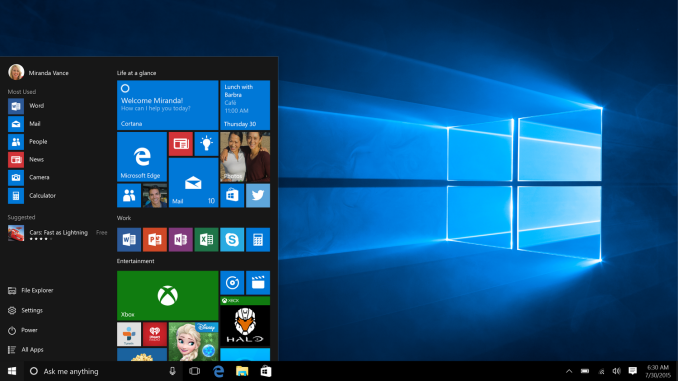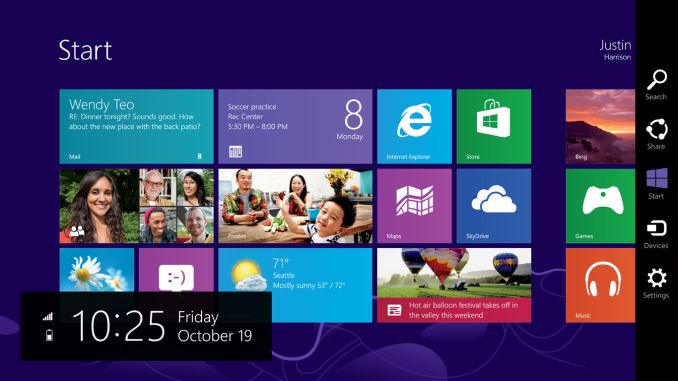The Windows 10 Review: The Old & New Face of Windows
by Brett Howse on August 25, 2015 8:00 AM EST- Posted in
- Operating Systems
- Microsoft
- Windows 10

Let’s flash back to 2012. About three years ago, Windows 8, the last major release of Microsoft’s ubiquitous operating system, was released to manufacturers. This was to be Microsoft’s most ambitious release yet. Traditional PC sales were in decline, and more personal devices such as the iPad tablet were poised to end the dominant PC platform. Microsoft’s response to this was to change Windows more than in any previous release, in a bid to make it usable with the tablet form factor. Windows 8 launched in October 2012 to much fanfare.
There was much fanfare, but little in the way of sales. Yes, Microsoft did sell many copies of Windows 8, but it did not help the declining PC market rebound. Windows 8 came to be with a touch first interface, with a new Start Screen replacing the traditional Start Menu, and a new breed of Windows 8 apps, which run on the WinRT framework. These WinRT apps have been named many things over the past three years, starting with Metro apps. A trademark dispute ended that naming scheme though, and over time they have morphed from full screen apps to universal apps to Windows Store apps, and practically none of them were able to rival the older Win32 platform in popularity or productivity.
Windows 8 did bring some great features to Windows, but they were overshadowed by the major design shift which, while good as a touch based operating system, alienated many who still used Windows on a traditional desktop or notebook. The Start Screen was a big turn off to many people, and full screen apps were not very efficient on a large screen display. Even the multitasking in Windows 8 was less than ideal, with the initial release only allowing two Windows Store apps to be open at any one time, and the second was relegated to a small side bar.
Microsoft’s own faith in Windows 8 was clearly not strong. Only a couple of weeks after Windows 8 launched, they unceremoniously dumped the project head Steven Sinofsky from the company, and spent the next two years trying to make Windows 8 more usable on traditional mouse and keyboard type machines, which were the vast majority of Windows devices in the hands of users. Windows 8.1 arrived and fixed some of the key issues with Windows 8, and 8.1 Update launched with the ability to boot to the desktop, and avoid the touch interface almost completely if you wanted to.
 Windows 10 Start Menu and Desktop view
Windows 10 Start Menu and Desktop view
When looking at Windows 10, I think it is pretty important to look back over the last three years, because none of this is ever built or designed in a vacuum. Microsoft has a huge number of devices running Windows, but a large majority of them are running Windows 7, which was an evolutionary desktop upgrade. Windows 8 struggled to ever take over any of that usage share. Windows 10 is Microsoft’s attempt to bridge the divide. Windows 7 is used by hundreds of millions of people, but its touch support is practically zero. Windows 8 works well in a touch scenario, but is not ideal for keyboard and mouse based devices. Windows 10 promises to be the version of Windows which bridges this gap.
Windows 10 brings about as much change as Windows 8 did, but in almost all cases it is going to be appreciated by users rather than avoided. It will run on a dizzying number of device types, including the traditional desktop, notebook, tablet, two-in-one, phone, IoT, Raspberry Pi, Hololens, Surface Hub, and even Xbox One. What it will bring to each of those device types is not the single interface that Windows 8 pushed on the desktop, but a unified app platform. Each device type will have its own interface, but the underlying app platform will allow developers to target a huge number of devices. And developer buy-in is the one thing Microsoft needs more than any other in order to make this vision succeed. For all of Windows 8’s quirks, it was really the lack of quality apps in the Windows Store which was the one hurdle Microsoft could not code around. Only time will tell whether or not the new model succeeds where the old one failed, but at the beginning of the life of Windows 10 we can go through all aspects of it and see what’s new, what’s changed, and how it fits in on today’s devices.











293 Comments
View All Comments
Notmyusualid - Saturday, August 29, 2015 - link
I don't get it - who, or what org would pay ME? For exposing Windows privacy failures? Who would pay for that? Why?postwarscars - Saturday, September 5, 2015 - link
Any competing entity? The point of advertisement isn't simply to sell something to someone, but also to dissuade the use of a similar product. Subversion in this space is not uncommon, so really the question should be why WOULDN'T they pay you to speak negatively of a product?Besides, weren't you worried about how much these companies supposedly think of you? How much they're interested in YOUR data. YOUR tendencies? YOUR life? If they care about your privacy, or any other random person's information, they would certainly care about your business as well.
You know how you can't take someone at face value because you believe they're marketing to you? It's the same here, how do we know you aren't lying to us either?
Perspective.
Alexey291 - Wednesday, August 26, 2015 - link
The sad thing (sad for ms not for me, I really couldn't give a shit about Windows anymore, it's there to launch games/steam and occasionally office) is that all these little changes all these small adjustments all these features like cortana all come with what is essentially mistrust from the users.Because both Windows and Microsoft are at this point such toxic brands that whatever they do whatever they add will be hated (saying it lightly here) by a fairly large amount of people.
I'm not going to upgrade because frankly there's no point doing so for me. Nothing I do in Windows will change because of 7 to 10 transition.
chrome_slinky - Wednesday, August 26, 2015 - link
Used it as an Insider from February to 3 days after launch. I could stand the irk no more. Windows 10 is just warmed over 8, with more hubris, and more intrusion. Oh, and fewer places where a right click works as it did in Windows 7 and below.It has been easy to spot the appearance of paid trolls in all the usual places, along with journalists who usually approach things fairly, gushing over the crap that is Windows Last - one can only assume they have gotten their checks from Redmond.
Dribble - Tuesday, August 25, 2015 - link
Think they should have held off showing that "update to windows 10" box for a few months on windows 7 until they got the update process working better. Windows 7 machines are considerably older then windows 8 ones and you get all sorts of funny spec's some of which don't work.If they'd hidden the update the tech savy enthusiasts would have done it, found most of the problems and stuck solutions on the web somewhere or microsoft would have fixed them. As it is lots of relatively clueless people see the box and click on it to update, and it then breaks their machine. My father in law being a case in point, he phoned me up complaining that the update had made all his files read only and he had spent many hours on the phone to windows support (mostly waiting for someone to do something) and that hadn't fixed it.
I (more sensibly) haven't updated to windows 10 yet, so I couldn't really help him.
chrome_slinky - Wednesday, August 26, 2015 - link
My experience has been that updates go fine, if you're not an idiot, and have adequate disk space, even with much older hardware. The problem is all the irk you find after the upgrade has completed.ScottSoapbox - Tuesday, August 25, 2015 - link
Windows 10 launched unfinished, but is rapidly getting updates. How long until windows as a service gets mostly feature complete / stable?I want to upgrade but avoid the early adopter headaches as I just too time starved. Thoughts?
jardows2 - Tuesday, August 25, 2015 - link
I upgraded on day 2. Didn't have time to do it on day 1. No, I emphasize absolutely no headaches in my upgrade process or usage to this point. YMMV.chrome_slinky - Wednesday, August 26, 2015 - link
Perhaps in a couple of years. And that is ONLY if Microsoft loses their "you must have things OUR WAY" stance. Most of us have long since left behind the need for paternalistic companies thinking they know best.jrs77 - Tuesday, August 25, 2015 - link
Windows 10 lags the Windows Classic UI. It also has too many of it's settings hidden away and not readily accesible. And the worst thing ofc is the Windows 10 EULA that allows Microsoft to deactivate any software I'm using at will, let alone them constantly scanning my entire system.No thanks, Windows 10 is total crap.